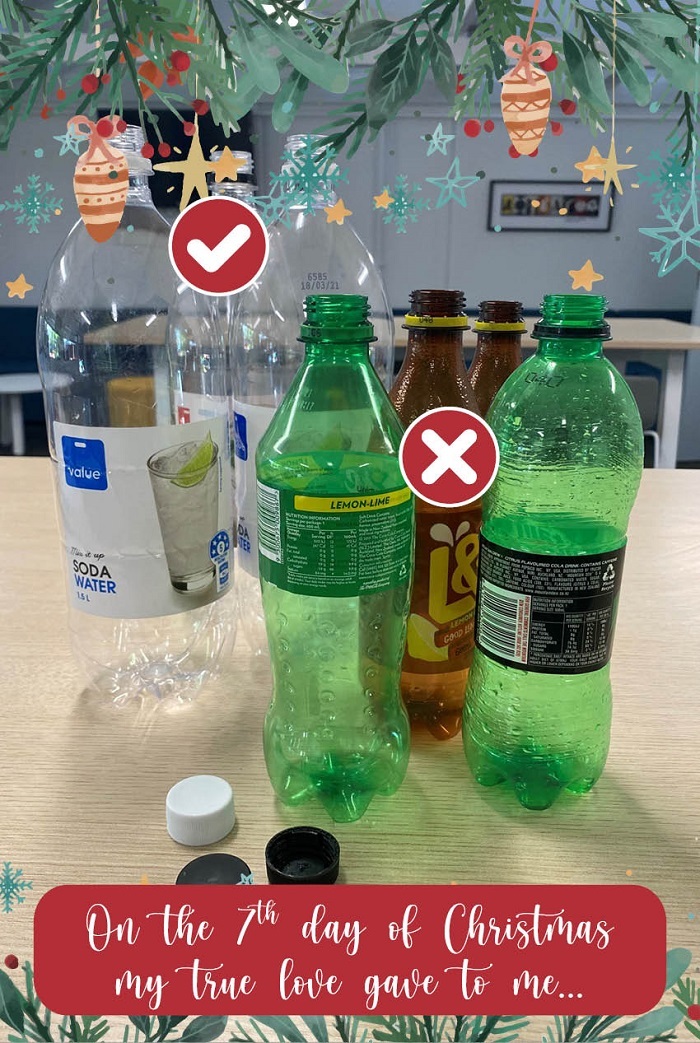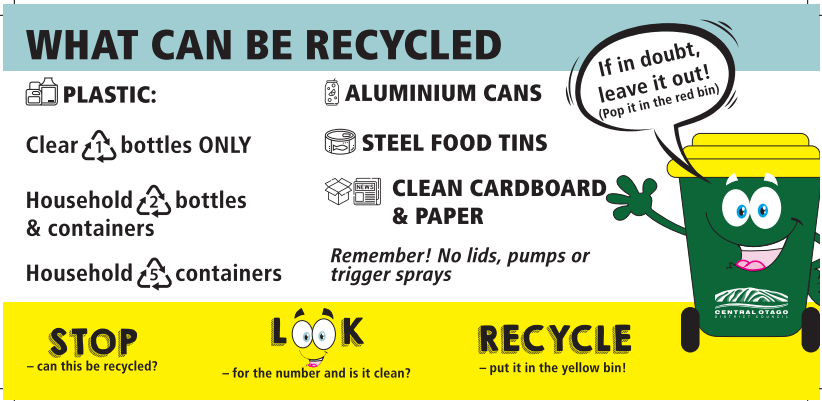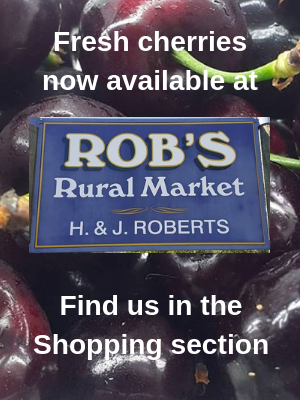Don't understand recycling changes? Here's some help
Rowan Schindler
10 December 2020, 3:30 PM
 As of December 1, Central Otago has changed what you can and can’t put into the recycling bin. Do you know the facts?
As of December 1, Central Otago has changed what you can and can’t put into the recycling bin. Do you know the facts? From 1 December 2020 Central Otago has joined the increasing number of districts only accepting plastics that are able to be recycled within Aotearoa/New Zealand.
The Central App attempts to make sense of what some people might be struggling with.
From now on, only plastics numbered 1, 2 and 5 will be accepted for recycling in your yellow kerbside recycling bin.
A second change is that pizza boxes, no matter how clean, will not be accepted for recycling in your yellow bin.
The change in plastic collection is being made to align with Aotearoa/New Zealand’s commitment to move away from using hard-to-recycle, low value plastics.
These are commonly processed overseas and contribute to the problematic international trade in plastic waste.
(Continue reading below)
Advertisement
The Central Otago District Council (CODC) website has a wealth of information on what can be recycled and why the changes have come into place.
“By focusing on higher value plastics with a transparent supply chain we can ensure that there are better environmental and social outcomes for our recycled items,” the CODC website states.
“This keeps valuable resources out of our landfill, creates employment within Aotearoa/New Zealand and helps us “close the loop” with effective recycling.”
The Government is also looking at standardising kerbside recycling nationwide, based on recommendations from a new report Standardising kerbside collections in Aotearoa.
Pizza boxes are very commonly contaminated with grease and food and this makes them unable to be recycled with other cardboard and paper.
It is very difficult to separate out what is too contaminated from what isn’t, so a blanket ban on these will improve the quality of our cardboard and paper recycling overall.
All other plastics are unable to be recycled and should be placed in the red topped bin.
Non-recyclables include: All soft plastic, number 1 plastic items that are not bottles (meat trays, cracker trays, punnets, clamshell packaging), number 1 plastic coloured bottles, any plastic items numbered 3, 4, 6 or 7 or with no number.

The Central Otago District Council is using social media, with a little added festive cheer, to communicate changes to recycling; such as clear plastics 1 are recyclable, coloured plastics 1 are not. Image courtesy CODC.
Pizza boxes are not accepted in the yellow recycling bin because they are often too contaminated by grease and food and can not be recycled.
However, this type of cardboard can make a great addition to your compost, or for layering on your vegetable garden to keep weeds down.
Alternatively, they can be used as a fire starter, or even better, dine in or make your own to avoid the waste altogether.
The following items can still go in your yellow mixed recycling bin:
- Clean aluminium drink cans
- Clean steel food cans
- Clean and dry paper and cardboard
As for meat trays and punnets, which cannot be recycled, these plastic items can be made of either number 1 or number 3 plastics and it can be difficult to tell these two plastics apart as they are manually sorted at the Materials Recovery Facility (MRF) in Frankton.
“Currently our recycling processor does not have an optical sorter that could overcome this issue, however planned upgrades will address this.”
There is currently no market in New Zealand to reprocess other types of plastic, so it has to go to landfill.
"Lids" covers a wide variety of items:
- Sometimes the lid is made of the same plastic as the main container and sometimes not.
- Sometimes the lid is the same colour as the main container and sometimes not.
- Sometimes the lid is quite a big part of the container and sometimes not.
- Sometimes the container has been well cleaned out and the lid replaced, and sometimes not.
Because of these variabilities, to increase the quality of our recycling and to simplify the process of recycling the messaging is no lids – of any kinds.

Stuck for what can and can’t be recycled? Just remember these rules. Image courtesy CODC.
“Often lids are left on a dirty container causing contamination of all other recycling when the lid inevitably falls off during processing - not to mention making it a bad workday for our hard-working recycling sorters,” the CODC website states.
“When plastic items are baled up for reprocessing, the smaller lids will often fall out and end up in landfill or causing littering issues.”
Other lids are pumps or triggers and possibly contain a mixture of plastic types and metals making them hard to recycle.
Please remove all lids from plastic items 1, 2 and 5 and place in your red rubbish bin – or find some creative reuse for them.
Change requires a collaborative approach involving councils, producers, manufacturers and the community, with central government as the key enabler.
“Last year we supported the Local Government Waste Manifesto as a remit at the Local Government New Zealand conference,” the CODC website states.
“They're calling on the Minister for the Environment to make key changes that will allow central and local government to work together to minimise waste to landfill and significant reductions in all waste classes.
“CODC is also working with our neighbouring districts and at a regional level to ensure we work to support the vision of our Waste Management and Minimisation Plan - Towards Zero Waste and a Sustainable Central Otago.”
How do I make sure I recycle right?
Follow these three simple steps to make sure your plastic recycling is right:
Look:
Check for a number on your plastic item -
- No number? This is unable to be recycled and should be placed in your red bin.
- Number 3, 4, 6 or 7? This is unable to be recycled and should be placed in your red bin.
- Number 1, 2 or 5? Great! Ready to recycle!
Prepare:
Empty out any contents and give it a good rinse.
- Remove ALL lids, trigger sprays or pumps. These need to go in your red bin, or see if you can find some creative use for them!
- Remove any shrink-wrapped plastic labelling (this should have a "zip" perforation for this purpose) and place this in your red bin.
Recycle!
Place your bin out at the kerbside before 7am on the day of collection, away from trees, power poles and parked cars.




